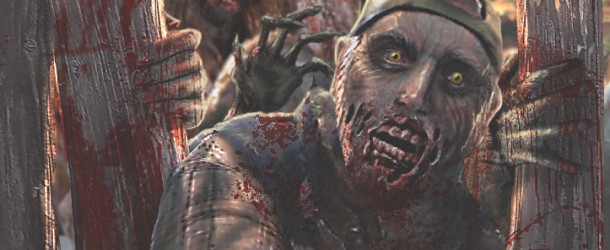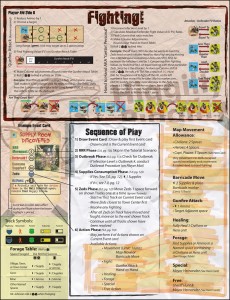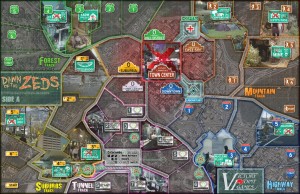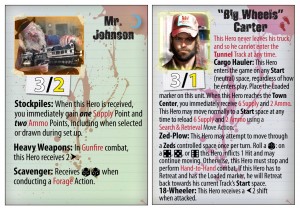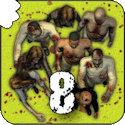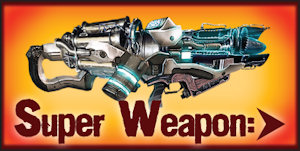By Fred Manzo
Dawn of the Zeds (Second Edition)
Zombies are hot. Hot, Hot, Hot. So how hot are they? Well, according to Wikipedia, the cable show The Walking Dead “has also attained strong Nielsen ratings, beating various records for a cable series, including receiving 12.3 million viewers for its mid-season 3 premiere to become the most-watched basic cable drama telecast in history.” In fact it’s become so popular it even has its own talk show “The Talking Dead, which “… features host Chris Hardwick discussing the latest episode with fans, actors, and producers.”
That’s hot! In fact, the only thing hotter these days is Abe Lincoln. I once even designed (but never got around to publishing) a zombie game myself: Zombies in Space. Maybe I should have worked in Lincoln.
So with that in mind what exactly did I find last week when I opened my review copy of Hermann Luttmann’s Zombie-fest Dawn of the Zeds*?
Soot and the smell of burnt cardboard.
Anyway, that’s what hit me when I first opened the box. Though for me, these weren’t bugs, they were features. After all, we are dealing with a post-apocalyptic situation here, aren’t we? Now, either to solve these problems or to show us we’re dealing with wisenheimers (or both) the gang at Victory Point Games also included a “Wipes-A-Lot” napkin with the game. In any event, after a couple of days, these problems disappeared.
The effects of laser cutters (and napkins) aside, the box also held two game maps each in two versions, a quick-start hand-out, 2 decks of cards and a 24 page rule book, which has an extensive example of play, the classic version of Dawn of the Zeds (DotZ), a tutorial version and an advanced game with short, medium and long scenarios. The game also came with a four page introductory hand-out, a detailed Player’s Aid cheat sheet, a player’s “Mat” containing all the charts you’d need, new counters and four new Heroes (Wright, Kingman, Wilson, and Carter).
In addition, various glitches from the first edition have been fixed. For example, originally there was a marker shortage (it actually wasn’t a shortage, but some of the little used markers were on the flip side of the always popular Chaos markers, so each time you used a marker to show the effects of Zombies passing through a captured village, you lost the use of the symbol on its reverse side).
“….ZEDS second edition is more than a mere face lift; it’s improved, expanded and enhanced to the best degree that we can make it. If you trust us to deliver the gameplay, believe me there is more now – TONS more – in the new ZEDS; and its better presented.”
– Alan Emrich
The Rules
Dawn of the Zeds is a point-to-point Card Driven Game much like The Fury of Dracula, but with strong wargaming elements that include combat units at the platoon or even the company equivalent level. In it a player is tasked with defending the town of Farmingdale** and its citizens against waves of attacking Zombies. To make matters worse, an epidemic of that dread disease “Z.E.D.” is spreading through the community. While things look decidedly grim for the defenders they are not without hope: they are armed and have some limited supply. They are also fortunate enough to have access to a high-level research facility and a world-class hospital but more importantly they count among their members a number of people with remarkable (but not super-human) abilities. The question is if this is enough to save their day.
Well, it probably isn’t, but what other chance do they have?
Dawn of the Zeds is played solo, though I can see it morphing into a cooperative game with the right group of people and while the rules are clear and complete, I’d say that on first sight, they do seem dense. This, however, is probably due to there being multiple scenarios and an inclination to overstate important points.
Anyway, what you do end up with is a detailed and theme heavy design, in which every gaming session produces something along the lines of a zombie movie, but with different heroes and a different ending every time you play.
Now, this is only the second design by Hermann Luttman that I’ve examined in detail, the first being Duel of Eagles in which I was a play-tester, but I must say that in both you’ll find an attention to detail that is remarkable. Take, for example, DotZ’s victory conditions. In most Euro-games victory conditions are purely an arbitrary afterthought. You count your victory points and you either have enough to win or you don’t. And why you won with, say, 10 VPs as opposed to 8 or 12 remains a mystery forevermore. Even in the wargame community, victory conditions are usually given short shrift (E.G., capture Berlin by turn 10 for a strategic victory etc. Why it won’t have been just as strategic if it had taken an extra month or two is never explained). In Dawn of the Zeds, on the other hand, not only are you provided with a clear and logical goal to work towards during play, but you are also given the reasoning behind the multiple levels of victory once the game ends. In one instance, due to the number of people you have saved and the research breakthroughs you have developed, you end up being mentioned as a possible U.S. Vice-Presidential candidate and in another the survivors sue you. While you’ve won in both cases, this extra bit of detail helps insure you’ll want to play this game again.
Basically, we are talking about a map, cards and counter game, in which the player controls the town’s defenders and the system controls the besieging Zombies. As the game progresses the Zombies work their way along four (or in the advanced games 5) tracks leading into Farmingdale and if any of them on the Highway, Forest, Mountain, Suburban or Tunnel tracks manage to reach the Town Center, you instantly lose. While there are outlying villages and various points of interest along the routes leading into town, the game boils down to a matter of either holding Farmingdale or not.
With Dawn of the Zeds being a Card Driven Game (CDG) you’d naturally expect cards to be its focus and you’d be right. The game includes 2 decks: the main “Event” deck and the smaller “Fate” deck. Each Event card drawn provides you with all the information you typically need for a single turn, including the sequence of play, any possible refugee and zombie movement, the minimum amount of supplies consumed, whether or not there is a new ZED outbreak, the number of Action Points the good guys are allotted and the random event you must trigger.
By the way, these events may occur in any phase and can be pro-player, pro-ZED or neutral. I’d say Events run 2 to 1 against the good guys. Occasionally, a random event or game procedure will also trigger the draw of a “Fate” card, usually in order to determine the location of the event. But no matter what the cause, once a “Fate” card is triggered the additional Event on it must also be conducted, which may generate even more chaos or very occasionally a new hero. This time, I’d say the cards are about evenly split between being pro-Good Guys and pro-Zombies.
Action Points
While Event cards are the engine of the game, Action Points are the fuel that powers it. Action Points are used by the good guys to move and attack with friendly units, forage for ammo and supplies, build barricades, research a cure for Z.E.D., heal hospitalized civilians and even develop a super-weapon. But, as you may have guessed, you’ll never have enough Actions to do everything you want to do.
Fundamentally, the game involves information markers and fighting units, with the fighting units further broken down into several kinds of Zombies and various good guys. A closer look at these good guys reveals they consist in the main of Heroes, civilians (think of them as locally organized militia units), refugee mobs and VIP survivors.
While VIP survivors help you with various victory conditions, refugees are un-armed civilian mobs that were released when their outlying villages fell to the Zombies. Until then, they were what you might call “low-information” citizens. Apparently, no matter how many warnings some people get, they just don’t take zombie attacks seriously. Can you believe that?
Nevertheless, these people are not completely useless, as once they reach the Town Center you have the option of arming them and sending them back to the front or letting them recover in a refugee camp. But the more refugees you arm, the harder it is to achieve the higher victory levels.
Civilian units, on the other hand, are generally poorly armed, but friendly, combat units.
To make matters more complicated, occasionally the defenders run across free-lance Raiders, who unfortunately seem more interested in fighting their way into your town in order to get their hands on your ammo then in rescuing anyone. Though, normally you don’t mind their trying as they will usual expend more ammo fighting Zombies on their way in then they will ever be able to carry away when they do get to you.
But the backbone of your defense will be your fast moving and hard hitting heroes. Like I’ve always said, you can never have enough heroes.
Heroes
It seems to be a little known fact that the Heroes in Dawn of the Zeds are patterned after real life heroes; they are, that is, if you are a New York Mets fan: Seaver, Hunt, Piazza and Johnson etc. Although, in the name of accuracy I must say Hermann got the town mascot wrong. The original Mets mascot was a beagle named Homer, not a German Shepard named Pickles.
Anyway, these ballplayer’s real life attributes occasionally even affect their DotZ’s avatars: Johnson and Piazza were the Mets heavy hitters and in the game they are armed with high powered rifles, Keith Hernandez was a Mets captain and in the game he’s the city’s mayor.
Perhaps this is simply Hermann’s way of reminding us that in order to save the situation, something on the order of the Miracle of ‘69 is called for? On the other hand, a real Mets fan would have worked in Marv Throneberry.
So far we’ve covered Zombies, VIPs, refugees, civilians, raiders and heroes and while that’s quite a lot of moving parts for one game, it’s far from being everything, especially in the second edition. For example, and to name only a few, we’ve failed to discuss Rangers, Security Guards, Toxic Zombies, a Mad scientist and his minions, his underground lair, a secret tunnel entrance, a collapsed bridge, a missing Super-Weapon component, a National Science lab, a minefield, a strong-point defense, a ferry, the interrogation room and the catacombs. Combining all these factors with 2 versions of the map, 4 or 5 scenarios and a dozen heroes with varying abilities generates a game with huge re-play value.
And we haven’t even dealt with Combat or Research yet.
Combat, etc.
Combat, Research and Healing rolls are all determined in the game with the help of 2D6 dice and their own charts in a fairly standard manner.
The Combat Results Table used, for instance, generates a binary result and causes the losing side to retreat. Heroes absorb 2 hits before being eliminated, civilian units 4 hits and Zeds 6, though the game uses an unusual method of keeping track of these casualties: only when you reach the halfway point in hits absorbed is a counter flipped to its reduced side.
So, an 8 strength Zeds counter will remain at strength 8 through its first and second hit. Once it takes a third hit, however, it will be flipped and become a 4 strength unit. And it will stay a four strength unit even after its fourth and 5th hit.
It will only be reduced to zero (that is, eliminated) once it takes a 6th hit. It may have taken 6 separate losses but it only reduced its fire-power twice: once to 4 and once to zero.
So occasionally you will find yourself facing a reduced 2 strength Zombie unit, with 2 casualties, that is attacking with a strength of two. It is something that takes getting used to.
The End Game
In another example of the thought put into this design, the game ends without generating “end of the world” problems. This is accomplished by placing the ‘National Guard relief column’ event somewhere in the last 8 cards of the deck, although even then they may have trouble breaking through to the town. So, no, you can’t game the situation by counting how many cards are left in order to eke out a marginal victory.
Victory
Victory conditions in the game basically boil down to you either surviving or not, as dead ties are impossible. However, your victory level can range across a rather wide spectrum. It all depends on who you saved, how many you saved, how you treated the survivors, whether or not you succeeded in finding a cure to Z.E.D. and if you developed an anti-Zombie Super-weapon.
Game Play
“….If there’s one thing Zeds will do for you, it’s give you narrative. That’s the whole point of the design – to take you on an adventure in a zombie movie or book. … [T]he problem with most Euros is that they are just ‘systems’ that are to be figured out. The theme is secondary (or non-existent). Zeds is the polar opposite – it’s almost all theme!”
Now, for how DotZ plays, I’d say just fine and yet I will admit it does take a special kind of gamer to fully appreciate it. After all, we are talking about a tense, defensive struggle that in all likelihood you will lose. But if these characteristics don’t bother you, or if, like me, you love solving tough problems, than this game is for you.
Strategy
Like all good books a first-rate game naturally generates new ideas once you’ve been introduced to it. And Dawn of the Zeds is no exception. Although I haven’t played Zeds long enough to be called adept, there are a few avenues I’d want to explore in future sessions. For example, I’d like to see what effect an excessive use of ammo would have on game play. (While attacks may be conducted either at long or short range, players usually prefer to attack via long range gunfire, due to the fact that any contact with Zombies, no matter how slight, will increase the town’s infection level and thus the chances of generating additional Zombie hordes.) In other words, would a defense centered on foraging for ammo and maximizing the number of long range gunfire attacks be a good or bad idea?
I’d also think setting up as many defense-in-depth positions as possible would help. As friendly combat units can’t stack, it appears the best defense should be a strong civilian unit behind a barricade, backed up by a sharp-shooting Hero, say Piazza or Johnson. Unfortunately, players usually have only three or four Heroes in any particular game and 9 or 10 positions they desperately need them to occupy (that’s 4 or 5 avenues of approach to cover, the town center, possibly the farm and/or the mine for some high value foraging plus the hospital and the lab), so as in all good games players will find many more options open to them then they can possible employ.
In addition, I also want to see how effective it would be to completely clear one track of Zombies and the chaos they generate. I’d think that as the Zombies win by attrition and the ability to overwhelm widely spaced defenders, one obvious counter-strategy would be to clear them completely from at least one track in the hopes of lowering their pressure on your defenses when they do advance. That is, say you cleared the Highway track of Zombies and the Chaos markers they leave in their wake and the next Event card says “Zombies on the Mountain and the Highway track advance.” It seems to me you’ve immediately reduced the pressure of the Zombie hordes by half for this turn. Of course, the card might just as easily have said “Zombies on the Forest and Mountain track advance,” but even in this case clearing the Highway would allow you to concentrate your remaining defenders on the approaches posing the greatest dangers. Now, I know that a “cleared” track will not stay clear for long, but when playing with your back against a wall every little advantage helps.
And in order to pay for these tactics I’d like to explore the possibility of under-funding super-weapon development, as it appears to me that no matter how powerful it is it’s simply not that cost effective. Yes, the resources you poured into research will help in your post-victory spin campaign to win the Vice-Presidency and I realize that during the defense of the town it does help in healing civilian units, but I’m not convinced it’s worth all that much effort when you will in all probability lose the game anyway. From my point of view, if most players are going to lose somewhere between 65 to 90 percent of the time, what real value did they derive from all the resources they poured in research?
Therefore, I’d like to try minimizing R and D funding and see what happens. Say, nothing for the first third of the game, a minimum in the second third and, if things stabilize, only then putting the pedal to the metal in the final third.
Of course, all this is one of the charms of DotZ. You play it and lose and you still have a good time and want to come back for more. In fact, the first thing you’ll say after losing Dawn of the Zeds is “What bad luck. But I’ll win next time.”
As is apparent, I believe this game has just the right level of detail to make it both playable and re-playable any number of times. And it is fun.
In fact, it reminds me of the sort of puzzles you’ll find in some of the harder defensive scenarios in Tank Battles 44 on the I-pad or even in the legendary board wargame Russian Campaign (if you like playing the Russians, that is) or in any situation modeling the 55 Days in Peking. So if your idea of a good time is to fight off waves of bad guys whose only goal in life, so to speak, is to overwhelm your position, give Dawn of the Zeds a try.
But remember, those zombies are deadicated.
Game Resources:
Player’s Aid card (basic)
Dawn of the Zeds FAQ (First Edition)
The easiest way to jump into this game, at least in my opinion, is to watch a few video run throughs, such as Paul Darcy’s
* = In the game “Zeds” stands for “Zombie Epidemic Disease” and in real life for how the last letter of the alphabet is pronounced in British – English.
** = Farmingdale is a nice suburban town located practically in the shadow of the Mets’ home field, but, as far as I can tell, it has never been overrun by the undead. Perhaps the Mets do ward off Zombies.
Disclaimer: I know Herman, but anyone who is familiar with me, knows I stand behind every single word I ever wrote. This game is great.


